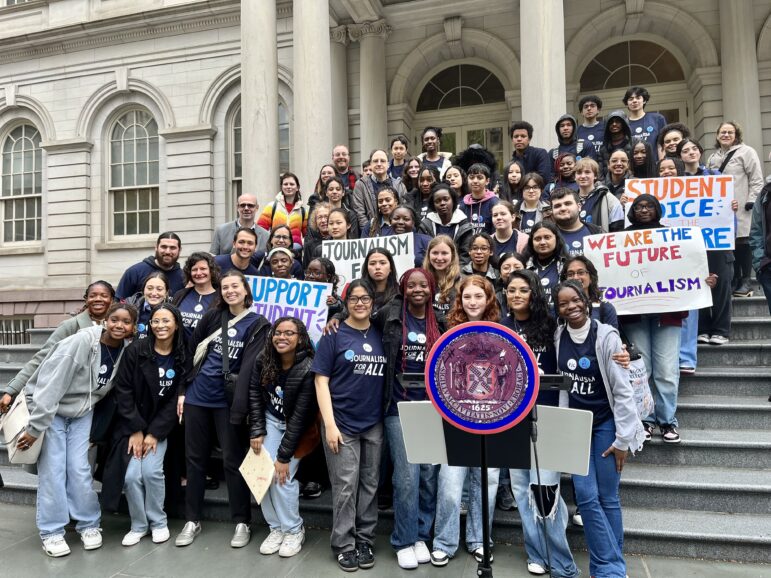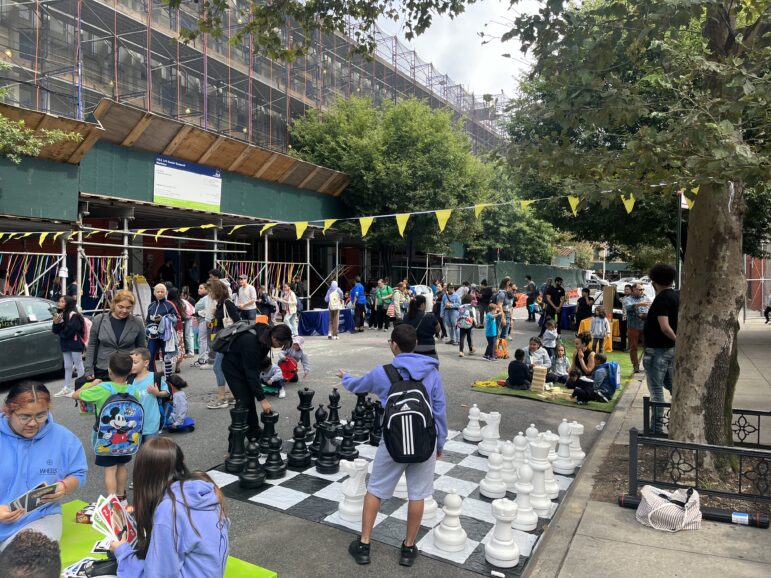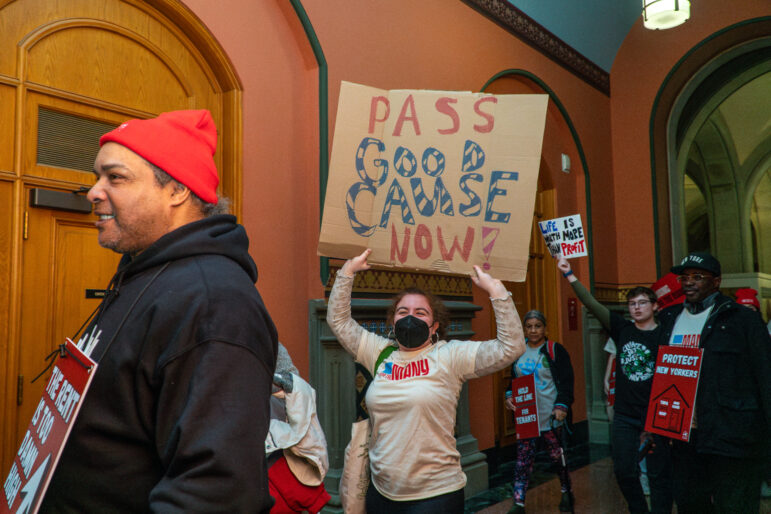From Sunset Park you can look at the New Jersey horizon opening onto the flat blue sky, with the little jets taking off from Newark Airport muddying the air behind them, and get the impression that America’s out there somewhere.
Sunset Park-the park, not the neighborhood-is a set on a hillock, and rises sharply, maybe 150 feet up from a Key Food on 5th Avenue. It terminates, 23 acres later, at 7th Avenue. In between are worn benches, Hondurans winging rubber basketballs, a huge WPA public swimming pool and mothers pushing strollers through the winding pathways.
It is a beautiful place, full of undistracted conversation and dogs breaking free of their leashes to run up the park’s long hill.
With the exception of Green-Wood Cemetery (which is of limited use to its year-round residents), Sunset Park sits on the highest point in all of Brooklyn. Which is a good thing too, considering that most of the city has no idea that this, its most interesting neighborhood, even exists. If ever a place needed the elevation, it’s this one.
_______
The neighborhood seems like it was created to be overlooked. It is jammed between four ostentatious neighbors. To the west is the sprawling waterfront, with its broad vistas of the lower harbor. Tenth Avenue is the eastern border leading into the noisy and politically powerful Jewish enclave of Borough Park. To the south is Bay Ridge, the stubborn heart of white Catholic Irish and Italian Brooklyn, with more bars per square mile, its denizens claim, than any place west of Limerick. Even Green-Wood Cemetery to the west is the final neighborhood of notables ranging from Mae West to Boss Tweed.
Sunset Park has never staked out a single, coherent identity because it has never had the luxury. It has always been a place where poor workers chased subsistence. When there were jobs, they moved in. When better work could be had elsewhere, they moved on. In terms of ethnicity, Sunset Park is rented by the generation.
For most of the last 150 years, immigrants came for jobs on the waterfront. By the middle of the 19th century, the sea trades outgrew the cramped quays of Red Hook, and docks began expanding southward along the long stretch of shoreline between the Atlantic Terminal and Bay Ridge.
With the docks came stevedores-Norwegians, Irish, Finns, Italians and Poles. The waterfront, as it was in Red Hook and the Navy Yard, was a no-mans-land of boilermakers, by-the-night flops, union halls and whorehouses.
But it was also a great economic engine, especially after the construction of the massive Bush Terminal in 1895 and the Brooklyn Army Terminal 18 years later. These facilities housed hundreds of companies and warehouses with tens of thousands of employees-at its height, the Bush Terminal served 25 steamship lines and had its own power plants, rail system and police force.
Wars have always been good to Sunset Park. During the Great War, trade boomed and 3rd Avenue blossomed into Little Scandinavia’s Broadway, lined with luncheonettes, candy stores and movie theaters. Up the hill, past 5th Avenue, grew Finn Town with its signature co-ops built by hand, materials paid for with cash-in-hand.
The docks and the neighborhood had a symbiotic relationship. A planner from Yale ended that by deciding that Sunset Park was too haphazardly laid out and inconvenient to the motorcar. In 1941, Robert Moses put a six-lane highway called the Gowanus Expressway on the pylons of the old 3rd Avenue elevated, creating a monstrosity that choked off almost all light and air from 3rd Avenue and hastened the flight of Scandinavians from the neighborhood.
But the neighborhood would have declined after its World War II boom even if Bob Moses had died in the crib. By mid-century, the greatest years of the city’s manufacturing and shipping days were over. Starting in 1950, the Army Terminal rapidly laid off all but 1,100 of its 40,000 workers. Factories closed, Bush Terminal’s trade dropped precipitously into the 1960s, and, eventually even the bars and whorehouses skulked away. In the end, Little Scandinavia died too.
_______
There had been a small Puerto Rican community in Sunset Park since the 1920s, mostly made up of factory workers. Their numbers held steady at about 2 percent of the neighborhood’s 100,000 residents as late as 1950. Then, in the mid-1950s, Puerto Rico’s rural economy failed, and a massive wave of immigration began. By 1970, about 40 percent of Sunset Park was Puerto Rican.
But the new residents inherited the same problems that had pushed out most of the Swedes, Finns and Norwegians: the loss of low or unskilled jobs in local factories and on the waterfront. By the 1970s, some 22 percent of the neighborhood’s residents were on welfare, and problems with drugs, alcoholism and gang violence came to the fore. Seventh Avenue, another thriving commercial strip, saw many businesses go under. It was rezoned residential and its stores bricked over.
But if the Scandinavian story is one of prosperity followed by a long, slow decline, the Hispanic history seems to be moving in the opposite direction. Starting in the mid-1960s, largely fueled by the community development and Puerto Rican pride movements, the city and local groups began to reclaim and renovate housing and the neighborhood’s institutions. The flagship effort was the 1969 construction of the new Lutheran Medical Center in an old waterfront factory building.
Then, starting in the mid-1980s, there came the avalanche of immigrants that has come to completely overwhelm any easy characterization of the neighborhood. Dominicans, Mexicans, Ecuadorians and Hondurans now occupy many of the cheaper apartments between 3rd and 5th avenues and have become the low-wage foot soldiers of city’s service industry-green-grocery workers, car service drivers, deliverymen.
At the same time, the Chinese enclaves that have always existed up on 8th Avenue and down by the Gowanus Expressway have exploded. Eighth, which was the heart of the old Polish section, now features 10 blocks of half-hidden garment factories, massive Chinatown-style dim sum palaces and live fish markets that blur the line between pet shop and food mart. The Chinese, like the Puerto Ricans, have also drawn other immigrants from their part of the world: Malaysians, Vietnamese, Koreans, Indonesians, Filipinos.
_______
Living in Sunset Park for two years was the most invigorating experience I’ve had in New York, and I’m from Brooklyn. There were nights I remember coming up the hill from the N Train on 4th Avenue, sometimes a little drunk, passing by one crowded sidestreet church, which always had a chair propping the door open. From time to time, somebody would ask me in, but I don’t speak Spanish, so I never did. On 8th Avenue in the daytime, I’d hear a chorus of Brooklyn accents and looking up, notice that the three people talking were Irish, Chinese and Dominican.
It was an emotional rush, but I was basically an outsider, so the rush would wear off. New York is famous for merciless change, but most neighborhoods have an order, a logic of place programmed into their pavement. But change seems to hit Sunset Park too quickly for even semi-permanent order to be established. Too many different kinds of people are jammed into too small of a space; the shifts are constant and subtle. If entire nationalities ebb and flow like commuters in Grand Central, imagine how any one person feels.
Fifth Avenue has been handed over to the Puerto Ricans, the Dominicans and now the Mexicans, but there are vestigial Irish remnants: bars, lawyers offices, funeral parlors. They function in oblivion, more or less-no one hassles them, it’s their neighborhood, too. But they are clearly past their time, arrested and uncool, like a 22-year-old still stuck in high school. In a few decades, the Puerto Rican shops will probably feel the same.
A few years back, I was quietly eating at a Polish diner on 8th Avenue when a mat of firecrackers detonated just outside. I hadn’t known it was Chinese New Year. As a goof, three men in a Dragon suit started whipping the tail against the plate glass. I looked around and everyone else in the place had laid aside their forkfuls of red cabbage in amazement. You could literally hear the clock on the wall ticking.
Not long after, I woke up the morning after a candlelit dinner and walked out in front of my building off 7th Avenue to find a police cordon and a bouquet of flowers laying in a rusty stain. One of the neighbors said, “A 14-year-old boy got shot here. Didn’t you hear it?”
I didn’t. I was living in a different neighborhood.







